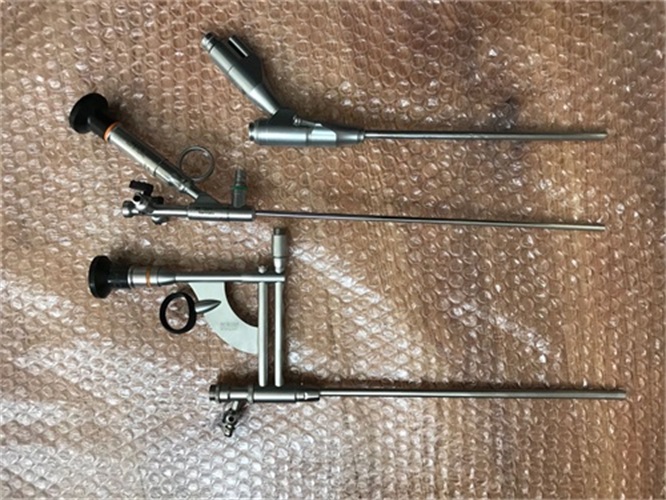内窥镜是集中了传统光学、人体工程学、现代电子、数学、软件等于一体的检测仪器。下面
内窥镜设备维修人员为您讲解一下软式内镜与硬式内镜两者间的差别怎么样。
Endoscope is a testing instrument integrating traditional optics, ergonomics, modern electronics, mathematics and software. The endoscopic equipment maintenance personnel will explain the difference between the soft endoscope and the hard endoscope.
1.外观不同
1. Different appearance
软式内镜:镜身材质柔软,可以弯曲,插入端部可以调整角度,甚至可达到180°。
Soft endoscope: The mirror body is soft and can be bent. The insertion end can be adjusted to an angle of 180 °.
硬式内镜:镜身主体不可弯曲或扭转,进入人体的深度远远低于软式内镜。
Hard endoscope: The main body of the mirror cannot be bent or twisted, and the depth into the human body is far lower than that of the soft endoscope.
2.结构不同
2. Different structures
软式内镜:一般包括以下基本构造:前端部,弯曲部,插入管,操纵部,接目部以及成像接口部。其前端部是硬性部分,端面有多个腔道和窗面,分别为送水送气出口孔,活检钳出口孔,物镜以及导光窗。
Soft endoscope: generally including the following basic structures: front end, bending part, insertion tube, manipulation part, eye connector and imaging interface part. The front end is a hard part, and the end face is provided with a plurality of cavities and windows, which are respectively a water and air supply outlet hole, a biopsy forceps outlet hole, an objective lens and a light guide window.
送水送气为共同出口,注气时,气体由此孔进入人体腔内使腔体扩张;注水时,水从此孔出来冲洗物镜镜面及手术野,使视野保持清晰。负压吸引及活检钳出口孔为同一管口,当腔内有过多液体妨碍观察时,按压吸引按钮,液体可由此孔吸入吸引瓶内。
Water supply and air supply are common outlets. During air injection, the gas enters the human cavity through this hole to expand the cavity; When water is injected, the water comes out from this hole to wash the objective lens surface and surgical field, so as to keep the vision clear. The negative pressure suction hole and the exit hole of the biopsy forceps are the same nozzle. When there is too much liquid in the cavity that hinders the observation, press the suction button, and the liquid can be sucked into the suction bottle through this hole.
活检钳和其他治疗器械也从此孔进入体腔内。操纵部包括角度控制旋钮,吸引阀按钮,送水送气按钮以及活检管开口,术者可以在此操作各种按钮已完成内镜检查和治疗。
The biopsy forceps and other therapeutic instruments also enter the body cavity from this hole. The operating part includes angle control knob, suction valve button, water and air supply button and biopsy tube opening, where the operator can operate various buttons to complete endoscopic examination and treatment.
硬式内镜:各类硬管内镜结构一般包括外镜管(或鞘套)、镜体、光导束接口、目端接管以及成像接口部分。与软式内镜均有操作孔道不同,部分硬式内镜镜身无器械及水气孔道,如腹腔镜、胸腔镜、纵膈镜、关节镜等;
Hard endoscope: various hard tube endoscope structures generally include external lens tube (or sheath), lens body, optical guide beam interface, eye end nozzle and imaging interface. Unlike soft endoscopes, some hard endoscopes have no instruments or air and water channels, such as laparoscope, thoracoscope, mediastinoscopy, arthroscope, etc;

3.应用不同
3. Different applications
软式内镜:主要通过人体的自然腔道来完成检查、诊断和治疗,如胃镜、肠镜、喉镜、支气管镜等主要通过人体的消化道、呼吸道及泌尿道进入人体。
Soft endoscopy: mainly through the natural cavity of the human body to complete the examination, diagnosis and treatment, such as gastroscope, enteroscope, laryngoscope, bronchoscope, etc., mainly through the human digestive tract, respiratory tract and urinary tract into the human body.
硬式内镜:主要进入人体无菌组织、器官或者经外科切口进入人体无菌腔室,如腹腔镜、胸腔镜、关节镜、椎间盘镜、脑室镜等。
Hard endoscope: It is mainly used to enter sterile tissues and organs of the human body or sterile chambers of the human body through surgical incision, such as laparoscope, thoracoscope, arthroscope, discoscope, ventriculoscope, etc.
4.清洗消毒流程不同
4. Different cleaning and disinfection processes
软式内镜:每次使用后均应进行清洗、中间漂洗、高水平消毒或灭菌、终末漂洗。
Soft endoscope: after each use, it shall be cleaned, rinsed in the middle, disinfected or sterilized at a high level, and rinsed at the end.
软式内镜从患者体内取出后要进行床旁预处理,在光源和视频处理器拆离前立即用含有清洗液的湿巾或纱布擦去表面污物,擦拭品一次性使用;每次使用后清洗前要进行测漏,如无条件至少每天测漏一次。清洗液应每清洗一条内镜后即更换。接触完整皮肤、粘膜的内镜需达到高水平消毒要求,接触破损皮肤、粘膜的内镜需达到灭菌要求。
After the flexible endoscope is taken out of the patient's body, the bedside pretreatment shall be carried out. Before the light source and video processor are removed, the dirt on the surface shall be wiped with a wet towel or gauze containing cleaning solution. The wipes shall be used once; Leakage detection shall be conducted after each use and before cleaning, and at least once a day if unconditionally. The cleaning solution shall be replaced after each endoscope is cleaned. Endoscopes in contact with intact skin and mucous membrane shall meet the requirements of high level disinfection, and those in contact with damaged skin and mucous membrane shall meet the requirements of sterilization.
硬式内镜:每次使用后均应清洗、漂洗、终末漂洗和灭菌。硬式内镜使用后用流动水初步冲洗,除去血液、粘液等污染物,管腔器械用压力水枪进行冲洗。可拆卸部分须拆至小单元后置于多酶洗液中浸泡,或用保湿剂进行保湿处理。硬式内镜一般要求灭菌。
Hard endoscope: it shall be cleaned, rinsed, rinsed and sterilized after each use. After use, the rigid endoscope shall be preliminarily flushed with flowing water to remove blood, mucus and other pollutants. The lumen instruments shall be flushed with a pressure water gun. The detachable parts must be disassembled into small units and then soaked in multi enzyme lotion, or moisturized with moisturizing agent. Sterilization is generally required for rigid endoscopes.
The difference between soft endoscope and hard endoscope lies in appearance and clinical application mode, and there are also slight differences in cleaning, disinfection, storage and maintenance. You can come to our website anytime if you don't know something http://www.jiangrenyiliao.cn Consult!


 公司:匠仁医疗设备有限公司
公司:匠仁医疗设备有限公司